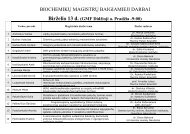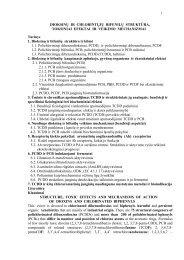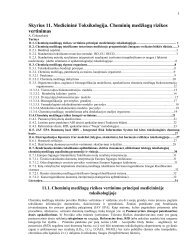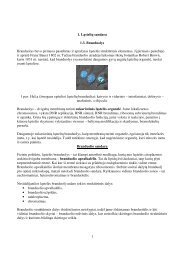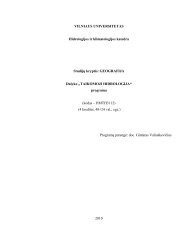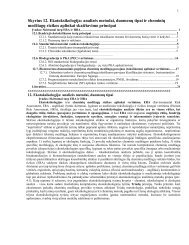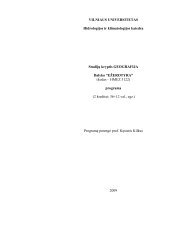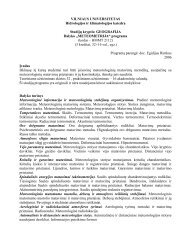Species and Their Formation - Laboratory of Visual Systems
Species and Their Formation - Laboratory of Visual Systems
Species and Their Formation - Laboratory of Visual Systems
You also want an ePaper? Increase the reach of your titles
YUMPU automatically turns print PDFs into web optimized ePapers that Google loves.
488 CHAPTER TWENTY-FOUR24.9 Geographically Separated,Morphologically Similar Althoughthey have been separated by theAtlantic Ocean for at least 20 millionyears, American <strong>and</strong> Europeansycamores have diverged very little inappearance.(a) Platanus occidentalis (American sycamore)(b) Platanus hispanica (European sycamore)Prezygotic barriers operate before fertilizationSeveral processes that operate before fertilization—prezygoticreproductive barriers—may prevent individuals <strong>of</strong> differentspecies from interbreeding:Spatial isolation. Individuals <strong>of</strong> different species mayselect different places in the environment in which to live.As a result, they may never come into contact duringtheir respective mating periods; that is, they are reproductivelyisolated by location.Temporal isolation. Many organisms have mating periodsthat are as short as a few hours or days. If the matingperiods <strong>of</strong> two species do not overlap, they will be reproductivelyisolated by time.Mechanical isolation. Differences in the sizes <strong>and</strong> shapes <strong>of</strong>reproductive organs may prevent the union <strong>of</strong> gametesfrom different species.Gametic isolation. Sperm <strong>of</strong> one species may not attach tothe eggs <strong>of</strong> another species because the eggs do notrelease the appropriate attractive chemicals, or the spermmay be unable to penetrate the egg because the twogametes are chemically incompatible.Behavioral isolation. Individuals <strong>of</strong> a species may reject, orfail to recognize, individuals <strong>of</strong> other species as matingpartners.Two closely related species <strong>of</strong> crickets from the isl<strong>and</strong> <strong>of</strong>Hawaii, Laupala paranga <strong>and</strong> Laupala kohalensis, provide an example<strong>of</strong> behavioral isolation. These two species live in separateareas <strong>and</strong> do not hybridize in nature, but they will forminterspecific pairs in the laboratory. The males <strong>of</strong> the twospecies produce genetically determined songs that differ inthe number <strong>of</strong> pulses per second. The songs <strong>of</strong> hybrid maleshave intermediate numbers <strong>of</strong> pulses (Figure 24.10). Femalesare much more strongly attracted to the songs <strong>of</strong> conspecificmales (males <strong>of</strong> their own species) than they are to the songs<strong>of</strong> males <strong>of</strong> the other species. We know that this preference isgenetically determined because hybrid females are moststrongly attracted to the songs <strong>of</strong> hybrid males.Sometimes the mate choice <strong>of</strong> one species is mediated bythe behavior <strong>of</strong> individuals <strong>of</strong> other species. For example,whether two plant species hybridize may depend on thepreferences <strong>of</strong> their pollinators. Because pollinators visit flowersto gather nutritional rewards, not to pollinate plants, pollinatorbehavior can be influenced only by changes in floralstructures that affect the rewards the pollinators receive. Floraltraits can affect reproductive isolation either by influencingpollinator behavior or by altering where pollen is depositedon the bodies <strong>of</strong> pollinators.The evolution <strong>of</strong> floral traits that generate reproductiveisolation has been studied in columbines <strong>of</strong> the genus Aquilegia.Columbines have undergone recent <strong>and</strong> very rapid spe-Number <strong>of</strong> individuals producing songswith that pulse frequency5040302010LaupalaparanigraF 1 hybrid generationPulse frequency <strong>of</strong>hybrid male songsdoes not overlapfrequencies <strong>of</strong> songs<strong>of</strong> parental males.Laupalakohalensis0 1.0 2.0 3.0 4.0 5.0Pulses per secondNarrow range <strong>of</strong>pulse frequenciesindicates strongstabilizing selection.24.10 Songs <strong>of</strong> Male Crickets are Genetically DeterminedHybrid males produce songs with intermediate pulse frequencies.




